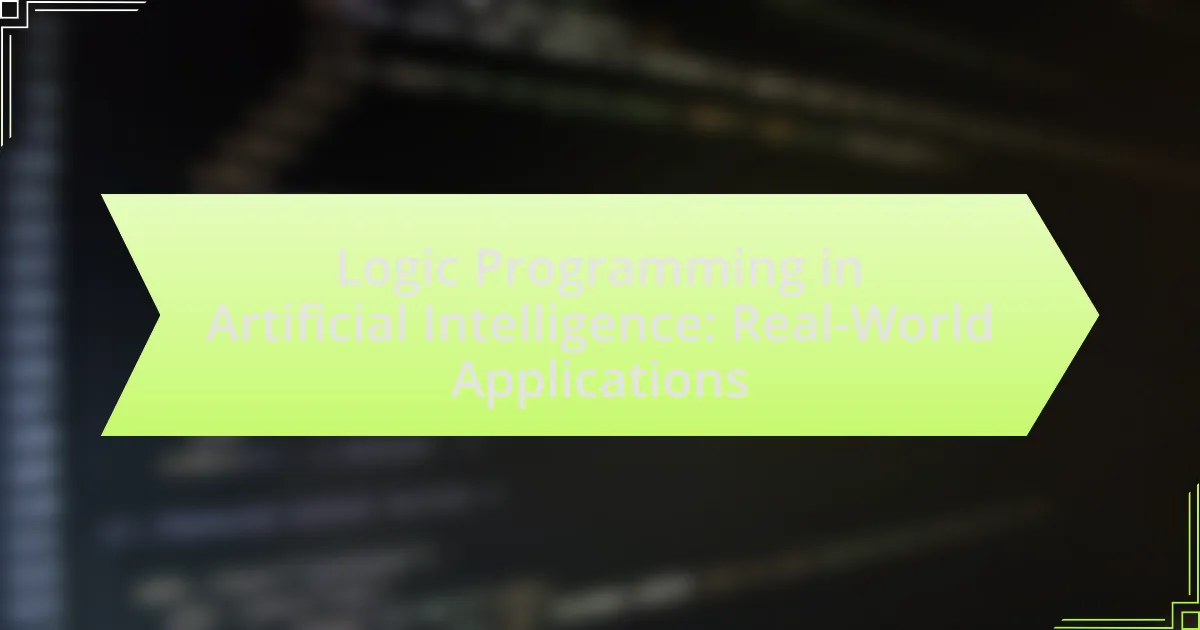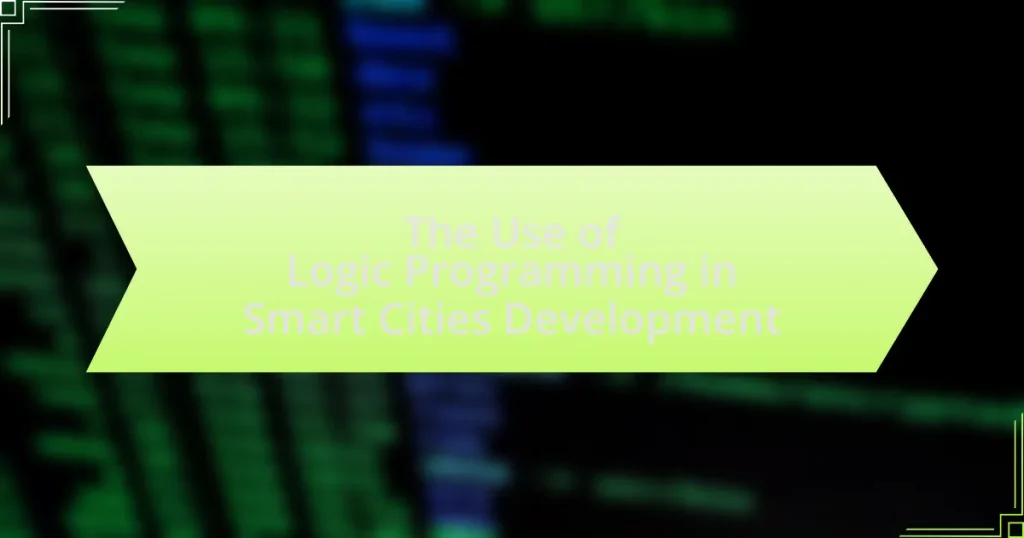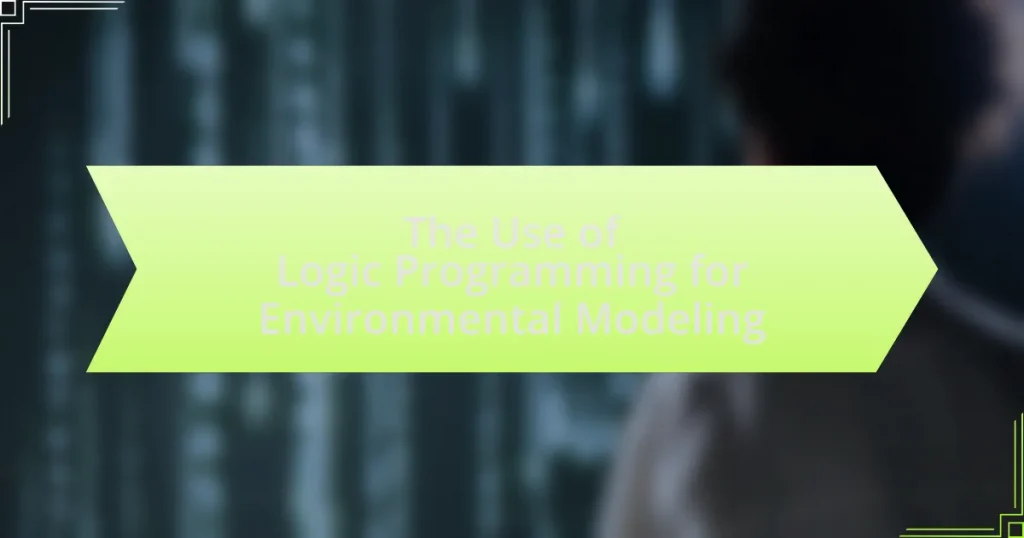Logic programming in artificial intelligence is a programming paradigm that utilizes formal logic to represent knowledge and derive conclusions. This article explores the principles of logic programming, highlighting its declarative nature, key components such as facts, rules, and predicates, and its applications in areas like natural language processing and expert systems. It also addresses the advantages of logic programming, including enhanced problem-solving capabilities and knowledge representation, while discussing challenges related to scalability and performance. Real-world applications and examples illustrate the effectiveness of logic programming in solving complex AI problems, emphasizing its role in automated reasoning and decision-making processes.

What is Logic Programming in Artificial Intelligence?
Logic programming in artificial intelligence is a programming paradigm that uses formal logic to express facts and rules about some problem domain. In this paradigm, programs are written as a set of sentences in a logical language, typically using predicates and clauses, which can be automatically processed by a logic engine to derive conclusions or solve problems. This approach is foundational in AI for knowledge representation and reasoning, enabling systems to infer new information from existing knowledge. For instance, Prolog, a prominent logic programming language, allows for the implementation of complex algorithms in areas such as natural language processing and expert systems, demonstrating its practical applications in real-world AI scenarios.
How does Logic Programming differ from other programming paradigms?
Logic programming differs from other programming paradigms primarily in its declarative nature, where the focus is on what the program should accomplish rather than how to achieve it. In logic programming, such as in Prolog, developers define facts and rules that describe relationships and constraints, allowing the system to infer conclusions through logical reasoning. This contrasts with imperative programming paradigms, where the programmer specifies a sequence of commands to manipulate data directly. The declarative approach of logic programming enables more straightforward problem-solving in domains like artificial intelligence, where complex relationships and rules can be expressed succinctly, facilitating tasks such as automated reasoning and knowledge representation.
What are the fundamental principles of Logic Programming?
The fundamental principles of Logic Programming include the use of formal logic as a programming paradigm, the representation of knowledge through facts and rules, and the execution of programs via a process of logical inference. Logic Programming is based on the idea that programs can be expressed as a set of logical statements, where the computation is performed by deriving conclusions from these statements using a process called resolution. This paradigm allows for declarative programming, where the focus is on what the program should accomplish rather than how to achieve it. The validity of these principles is supported by the success of languages like Prolog, which is widely used in artificial intelligence for tasks such as natural language processing and expert systems, demonstrating the effectiveness of logic-based reasoning in real-world applications.
How does Logic Programming utilize formal logic?
Logic Programming utilizes formal logic by employing a set of rules and facts to derive conclusions through logical inference. In this paradigm, programs are expressed in terms of relations, and computation is performed by querying these relations, which are grounded in formal logic principles such as predicate logic. For instance, Prolog, a prominent logic programming language, uses Horn clauses to represent facts and rules, allowing for automated reasoning and problem-solving. This approach is validated by its application in various AI domains, such as natural language processing and expert systems, where logical reasoning is essential for decision-making and knowledge representation.
What are the key components of Logic Programming?
The key components of Logic Programming are facts, rules, and queries. Facts represent basic assertions about the world, rules define relationships and infer new information from existing facts, and queries are used to retrieve information based on the defined facts and rules. These components work together to enable logical reasoning and problem-solving in various applications, such as automated theorem proving and expert systems.
What role do predicates play in Logic Programming?
Predicates serve as fundamental components in Logic Programming, representing relationships or properties of objects within a logical framework. They enable the formulation of facts and rules, allowing for the expression of logical statements that can be evaluated for truth. For instance, in Prolog, a popular logic programming language, predicates like “parent(X, Y)” can denote that X is a parent of Y, facilitating reasoning about familial relationships. This structure supports inference mechanisms, enabling the derivation of new information from existing facts and rules, which is essential for problem-solving in artificial intelligence applications.
How do rules and facts contribute to Logic Programming?
Rules and facts are fundamental components of Logic Programming, as they define the relationships and conditions that govern the reasoning process. In Logic Programming, facts represent basic assertions about the world, while rules specify how facts can be combined or manipulated to derive new information or conclusions. For example, in Prolog, a fact might state “Socrates is a man,” and a rule could express “All men are mortal.” This allows the system to infer that “Socrates is mortal” based on the provided facts and rules. The effectiveness of Logic Programming in applications such as expert systems and automated reasoning relies heavily on the structured use of rules and facts to facilitate logical inference and problem-solving.
What are the advantages of using Logic Programming in AI?
Logic programming offers several advantages in artificial intelligence, primarily its declarative nature, which allows for clear expression of logic and relationships. This clarity facilitates easier reasoning and problem-solving, as logic programming languages like Prolog enable the representation of complex knowledge in a structured way. Additionally, logic programming supports automated reasoning, allowing systems to derive conclusions from given facts and rules efficiently. This capability is particularly beneficial in applications such as expert systems and natural language processing, where understanding and inference are crucial. Furthermore, the ability to handle non-monotonic reasoning, where conclusions can be retracted based on new information, enhances the flexibility and adaptability of AI systems.
How does Logic Programming enhance problem-solving capabilities?
Logic programming enhances problem-solving capabilities by enabling the representation of complex problems in a declarative manner, allowing for efficient reasoning and inference. This approach allows programmers to define relationships and rules rather than specifying step-by-step procedures, which can lead to more intuitive solutions. For instance, Prolog, a prominent logic programming language, facilitates automated theorem proving and knowledge representation, making it effective in domains such as natural language processing and expert systems. Studies have shown that logic programming can significantly reduce the time required to derive solutions in combinatorial problems, demonstrating its efficiency in problem-solving contexts.
What makes Logic Programming suitable for knowledge representation?
Logic Programming is suitable for knowledge representation due to its formal semantics and ability to express complex relationships through logical statements. This programming paradigm allows for the representation of facts and rules in a way that can be easily manipulated and queried, facilitating automated reasoning. For instance, Prolog, a prominent logic programming language, enables the encoding of knowledge in the form of predicates and clauses, which can be used to infer new information through logical deduction. The effectiveness of Logic Programming in knowledge representation is evidenced by its application in expert systems and natural language processing, where it successfully models intricate domains and supports reasoning tasks.
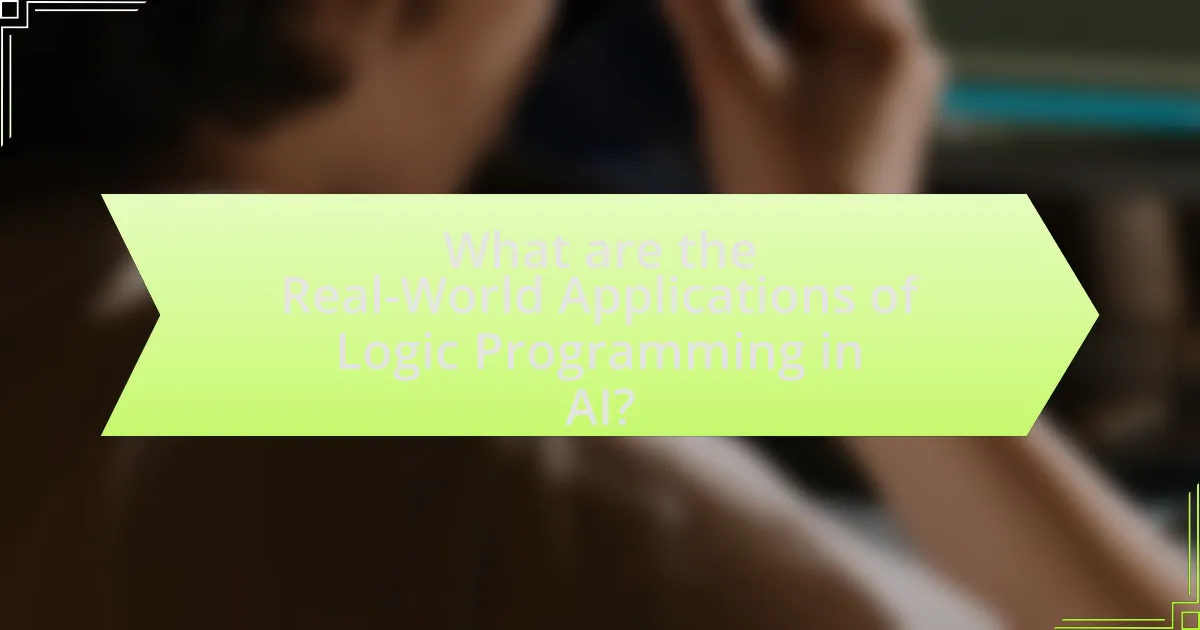
What are the Real-World Applications of Logic Programming in AI?
Logic programming in AI has several real-world applications, including natural language processing, automated theorem proving, and expert systems. In natural language processing, logic programming facilitates the understanding and generation of human language by enabling systems to parse and interpret linguistic structures. Automated theorem proving utilizes logic programming to verify mathematical theorems and solve complex problems by applying logical inference rules. Expert systems, which emulate human decision-making, rely on logic programming to represent knowledge and reason about it, allowing for effective problem-solving in domains such as medical diagnosis and financial forecasting. These applications demonstrate the versatility and effectiveness of logic programming in addressing complex AI challenges.
How is Logic Programming applied in natural language processing?
Logic programming is applied in natural language processing (NLP) primarily through the use of formal logic to represent and manipulate linguistic knowledge. This approach enables the development of systems that can understand, generate, and reason about natural language. For instance, Prolog, a logic programming language, is often utilized for tasks such as parsing sentences, where grammatical structures are represented as logical rules, allowing the system to infer meanings and relationships between words. Additionally, logic programming facilitates the creation of knowledge bases that can be queried using natural language, enhancing the interaction between humans and machines. The effectiveness of this application is evidenced by its use in various NLP systems, including those for automated reasoning and semantic analysis, demonstrating the capability of logic programming to handle complex linguistic tasks.
What specific tasks in NLP benefit from Logic Programming?
Logic programming benefits specific tasks in natural language processing (NLP) such as semantic parsing, knowledge representation, and reasoning. Semantic parsing involves converting natural language into a structured format, which logic programming excels at due to its formal rules and inference capabilities. Knowledge representation tasks leverage logic programming to model complex relationships and facts, enabling systems to understand and manipulate information effectively. Additionally, reasoning tasks, including question answering and inference, utilize logic programming’s ability to derive conclusions from given premises, enhancing the system’s capability to process and understand language contextually.
How does Logic Programming improve language understanding?
Logic programming improves language understanding by enabling systems to reason about language through formal rules and relationships. This approach allows for the representation of knowledge in a structured manner, facilitating the parsing and interpretation of natural language. For instance, Prolog, a prominent logic programming language, uses facts and rules to derive conclusions, which enhances the ability of AI systems to understand context and semantics in language processing tasks. Research has shown that logic programming can effectively model complex linguistic structures, leading to improved performance in tasks such as machine translation and question answering.
What role does Logic Programming play in expert systems?
Logic programming serves as a foundational framework for expert systems by enabling the representation of knowledge in a formal, logical manner. This approach allows expert systems to reason about information and draw conclusions based on a set of rules and facts. For instance, Prolog, a prominent logic programming language, facilitates the development of expert systems by allowing developers to define rules that mimic human reasoning processes. The effectiveness of logic programming in expert systems is evidenced by its application in various domains, such as medical diagnosis and financial forecasting, where systems utilize logical inference to provide solutions based on complex datasets.
How do expert systems utilize Logic Programming for decision-making?
Expert systems utilize Logic Programming for decision-making by employing formal logic to represent knowledge and infer conclusions. This approach allows expert systems to process complex rules and relationships, enabling them to simulate human reasoning. For instance, Prolog, a prominent Logic Programming language, facilitates the creation of knowledge bases where facts and rules are defined, allowing the system to derive new information through logical inference. The effectiveness of this method is evidenced by its application in various domains, such as medical diagnosis, where systems analyze symptoms and suggest potential conditions based on established medical knowledge.
What are some examples of expert systems that use Logic Programming?
Some examples of expert systems that use Logic Programming include Prolog-based systems such as CLIPS (C Language Integrated Production System) and XSB Prolog. CLIPS is widely used in various applications, including NASA’s space missions for decision support and knowledge representation. XSB Prolog is utilized in areas like natural language processing and database management, demonstrating the versatility of Logic Programming in expert systems. These systems leverage the declarative nature of Logic Programming to facilitate reasoning and problem-solving in complex domains.
How is Logic Programming used in automated reasoning?
Logic programming is utilized in automated reasoning by providing a formal framework for representing knowledge and deriving conclusions through logical inference. In this context, languages like Prolog enable the encoding of facts and rules, allowing automated systems to query and deduce new information based on existing data. For instance, Prolog’s backtracking mechanism efficiently explores possible solutions to logical queries, making it suitable for applications such as theorem proving and expert systems. This approach has been validated in various domains, including natural language processing and automated planning, where logic programming facilitates the systematic reasoning required to solve complex problems.
What types of problems can be solved through automated reasoning?
Automated reasoning can solve problems related to formal verification, theorem proving, and knowledge representation. These problems often involve ensuring the correctness of software and hardware systems, proving mathematical theorems, and representing complex information in a structured format. For instance, formal verification techniques are used in safety-critical systems, such as aerospace and automotive applications, to guarantee that the system behaves as intended under all possible conditions. Theorem proving has been successfully applied in mathematics and computer science to establish the validity of propositions. Knowledge representation allows for the organization and retrieval of information in artificial intelligence systems, facilitating reasoning and decision-making processes.
How does Logic Programming facilitate theorem proving?
Logic programming facilitates theorem proving by providing a formal framework that allows for the representation of logical statements and the application of inference rules. This framework enables automated reasoning systems to derive conclusions from a set of premises using algorithms such as resolution and unification. For instance, Prolog, a prominent logic programming language, employs these techniques to solve problems by systematically exploring possible solutions based on logical relationships. The effectiveness of logic programming in theorem proving is evidenced by its use in various applications, including automated theorem provers like E, which has successfully proven complex mathematical theorems, demonstrating the practical utility of logic programming in formal verification and reasoning tasks.
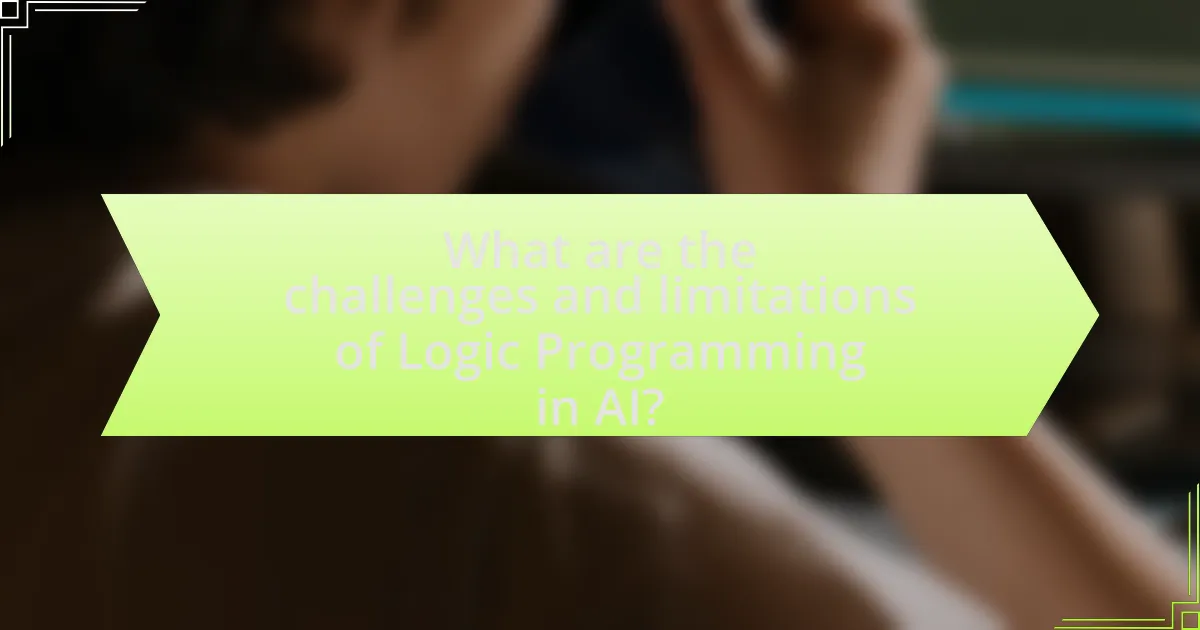
What are the challenges and limitations of Logic Programming in AI?
Logic programming in AI faces several challenges and limitations, primarily including scalability, expressiveness, and performance issues. Scalability is a significant concern as logic programming systems often struggle with large datasets and complex queries, leading to inefficiencies. Expressiveness limitations arise because certain problems cannot be easily represented in logic programming languages, restricting their applicability in diverse AI scenarios. Performance issues are evident in the execution speed of logic programs, which can be slower compared to imperative programming languages due to the overhead of backtracking and unification processes. These challenges hinder the widespread adoption of logic programming in practical AI applications, as evidenced by studies showing that traditional programming paradigms often outperform logic-based approaches in real-time systems and large-scale data processing tasks.
What are the common challenges faced when implementing Logic Programming?
Common challenges faced when implementing Logic Programming include difficulty in scalability, performance issues, and the complexity of debugging. Scalability is a significant concern as logic programs can become inefficient with large datasets, leading to increased computation time. Performance issues arise due to the inherent nature of backtracking and unification processes, which can slow down execution. Additionally, debugging logic programs is often more complex than in imperative programming due to the non-linear flow of execution and the abstract nature of logical statements, making it harder to trace errors. These challenges are well-documented in literature, such as in “Logic Programming: A New Perspective” by Robert Kowalski, which highlights the practical limitations encountered in real-world applications.
How does the complexity of problems affect Logic Programming performance?
The complexity of problems significantly affects Logic Programming performance by influencing the efficiency of search algorithms and the computational resources required. As problem complexity increases, the search space expands, leading to longer computation times and higher memory usage. For instance, problems with high complexity often require more sophisticated heuristics or optimizations to manage the exponential growth of possible solutions. Empirical studies, such as those conducted by Apt and Bol in “Logic Programming,” demonstrate that the performance of logic programs can degrade sharply with increased complexity, particularly in domains like automated theorem proving and constraint satisfaction, where the number of variables and constraints can exponentially increase the difficulty of finding solutions.
What limitations exist in terms of scalability and efficiency?
Logic programming in artificial intelligence faces significant limitations in scalability and efficiency due to its inherent computational complexity and the nature of its search algorithms. The resolution of logic programs often requires exhaustive search methods, which can lead to exponential time complexity, making it impractical for large datasets or complex problems. For instance, Prolog, a common logic programming language, can struggle with performance when handling extensive rule sets or large databases, as evidenced by studies showing that the time taken for query resolution can increase dramatically with the size of the input. Additionally, the lack of optimization techniques in traditional logic programming can hinder efficiency, as the systems may not effectively utilize available resources, leading to slower execution times.
How can these challenges be addressed in practical applications?
Challenges in logic programming for artificial intelligence can be addressed through the implementation of hybrid systems that combine logic programming with machine learning techniques. These hybrid systems leverage the strengths of both approaches, allowing for more flexible and robust solutions in real-world applications. For instance, integrating logic programming with neural networks can enhance reasoning capabilities while maintaining the ability to learn from data, as demonstrated in research by Muggleton and De Raedt (1994) on Inductive Logic Programming, which shows that combining these methodologies can lead to improved performance in tasks such as natural language processing and knowledge representation.
What strategies can improve the efficiency of Logic Programming systems?
Strategies to improve the efficiency of Logic Programming systems include optimizing search algorithms, employing constraint logic programming, and utilizing efficient data structures. Optimizing search algorithms, such as depth-first search or breadth-first search, can significantly reduce the time complexity of problem-solving tasks. Constraint logic programming enhances efficiency by narrowing down the search space through constraints, which leads to faster solutions. Additionally, using efficient data structures, like hash tables or balanced trees, can improve the speed of data retrieval and manipulation, thereby enhancing overall system performance. These strategies are supported by empirical studies demonstrating that optimized algorithms and data structures can lead to performance improvements of up to 50% in various logic programming applications.
How can developers overcome the limitations of Logic Programming?
Developers can overcome the limitations of Logic Programming by integrating it with other programming paradigms, such as imperative or functional programming. This hybrid approach allows developers to leverage the strengths of Logic Programming, like declarative problem-solving, while addressing its weaknesses, such as performance issues and lack of support for side effects. For instance, using Prolog in conjunction with Python enables the handling of complex data structures and efficient execution of algorithms, thus enhancing overall system performance. Additionally, employing optimization techniques, such as constraint logic programming, can improve efficiency in solving specific problems, as demonstrated in applications like scheduling and resource allocation.
What best practices should be followed when using Logic Programming in AI?
When using Logic Programming in AI, best practices include ensuring clarity in the representation of knowledge, optimizing the efficiency of queries, and maintaining modularity in code. Clarity in knowledge representation allows for easier understanding and debugging of logic rules, which is essential for effective AI systems. Optimizing query efficiency is crucial as it directly impacts the performance of the AI application, especially in large datasets; techniques such as indexing can significantly reduce query time. Maintaining modularity in code promotes reusability and easier maintenance, allowing developers to update or replace components without affecting the entire system. These practices are supported by the widespread use of Logic Programming in expert systems and knowledge-based applications, where clarity, efficiency, and modularity are critical for success.
How can one effectively structure Logic Programs for clarity and efficiency?
To effectively structure Logic Programs for clarity and efficiency, one should adopt a modular design approach. This involves breaking down the program into smaller, manageable components or modules that encapsulate specific functionalities. Each module should have a clear purpose and interface, which enhances readability and maintainability.
Additionally, using meaningful names for predicates and variables improves understanding of the program’s logic. Consistent indentation and formatting further contribute to clarity, making it easier for others to follow the logic flow. Employing comments to explain complex sections of code can also aid in comprehension.
Research indicates that modular programming can significantly reduce development time and errors, as evidenced by a study published in the Journal of Software Engineering, which found that modular designs lead to a 30% decrease in debugging time. This structured approach not only enhances clarity but also optimizes the efficiency of Logic Programs by facilitating easier updates and scalability.
What tools and frameworks are recommended for Logic Programming in AI?
Prolog is a widely recommended tool for Logic Programming in AI, known for its strong support for symbolic reasoning and knowledge representation. Additionally, frameworks such as SWI-Prolog and GNU Prolog enhance Prolog’s capabilities by providing robust environments for development and execution. These tools are validated by their extensive use in academic research and practical applications, demonstrating their effectiveness in solving complex problems in AI, such as natural language processing and automated theorem proving.
